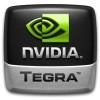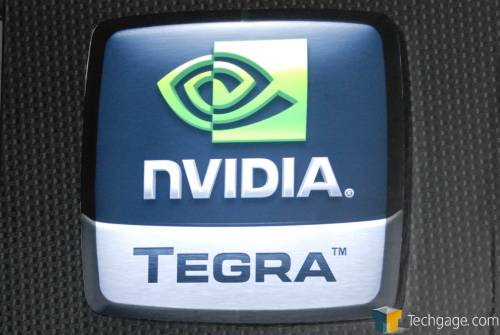- Qualcomm Launches Snapdragon 4 Gen 2 Mobile Platform
- AMD Launches Ryzen PRO 7000 Series Mobile & Desktop Platform
- Intel Launches Sleek Single-Slot Arc Pro A60 Workstation Graphics Card
- NVIDIA Announces Latest Ada Lovelace Additions: GeForce RTX 4060 Ti & RTX 4060
- Maxon Redshift With AMD Radeon GPU Rendering Support Now Available
Splitting The Atom: NVIDIA Tegra

NVIDIA took the opportunity at Computex to announce a brand-new chip series: Tegra. This high-performance/low power ‘system on a chip’ is set out to take on Intel’s Atom, and if all of NVIDIA’s claims are spot-on, everyone is going to want to have the chip in their mobile device once available.
Page 2 – What’s More? Final Thoughts
The largest benefits to be seen from Tegra, however, are not really software-based, but rather what the chip can handle from the hardware level.
When Michael Rayfield, General Manager of the Mobile Business Unit at NVIDIA, first mentioned that the Tegra processor could output to 1080p without a problem, he immediately went into a demo. In his hand was a regular MID about the size of his hand, that was playing Ratatouille on the projector in full 1080p. It ran incredibly well, with zero lag.
Then of course we come back to power efficiency. On display were two UMPCs – one running an Atom CPU at 800MHz, and another running the Tegra 650, also at 800MHz. Both were connected to power analyzers, and while the Atom-based UMPC drew 13.0W on average, the Tegra model scaled that way down to 1.3W.
It goes without saying that such performance in a small chip is highly desirable. With so many people wanting to bring their digital content or web services with them, great battery-life is imperative, but today, there are no devices available that allow you to go all day without having to charge it.
In one slide that NVIDIA showed, battery-life on Tegra was around 10x better than on Atom… but on top of it, performance was also better. During SD video playback, an Atom-based unit lasted around 2 hours, while the Tegra unit running 720p video lasted just over 25 hours. That is one massive statement, and if true, then Intel is really going to have to go back to the drawing board.
NVIDIA’s will launch three different versions of the Tegra, with the leading model being the 650, at 800MHz. The next step down is the Tegra 600, weighing in at 700MHz. It also has weaker overall battery-life (yet still highly impressive), and also lacks 1080p output.
|
Tegra 650
|
Tegra 600
|
Tegra APX 2500
|
|
| Processor | ARM11 MPCore 800MHz NAND Flash support16/32-bit LP-DDR |
ARM11 MPCore 700MHz NAND Flash support16/32-bit LP-DDR |
ARM11 MPCore NAND Flash support16/32-bit LP-DDR |
| HD A/V Processor | 1080p H.264 Encode 720p H.264 Decode AAC, AMR, WMA, MP3 Audio |
720p H.264 Decode and VC-1/WMV9 Decode 720p H.264 Encode AAC, AMR, WMA, MP3 Audio |
720p H.264 Decode and VC-1/WMV9 Decode 720p H.264 Encode AAC, AMR, WMA, MP3 Audio |
| ULP (Ultra Low Power) GeForce | OpenGL ES 2.0 Programmable pixel shader Programmable vertex and lighting Advanced 2D/3D |
OpenGL ES 2.0 Programmable pixel shader Programmable vertex and lighting Advanced 2D/3D |
OpenGL ES 2.0 Programmable pixel shader Programmable vertex and lighting Advanced 2D D3D Mobile |
| nPower Technology | 130 hours audio 30 hours HD video |
100 hours audio 10 hours HD video |
100 hours audio 10 hours HD video |
| Imaging | 12.0 megapixel camera support Intergrated ISP Advanced imaging features |
12.0 megapixel camera support Intergrated ISP Advanced imaging features |
12.0 megapixel camera support Intergrated ISP Advanced imaging features |
| Display | True dual-display support 1920×1200 / HDMI 1680×1050 / LCD 1280×1024 / CRT NTSC/PAL Output |
True dual-display support 1280×720 / HDMI 1280×1024 / LCD 1280×1024 / CRT NTSC/PAL Output |
True dual-display support 1280×720 / HDMI 864×480 / LCD 864×480 / CRT Composite/S-Video |
The last model is the APX 2500, which was launched earlier this year, and is designed exclusively for smartphones and handsets.
Also touched up on during the conference was the 3D capabilities for the chip, using a mobile version of GeForce, most often considered GoForce. With it, users can both enjoy rich user interfaces and also some light 3D gaming.
On screen was Quake 3 playing at 35 FPS, but I’m unsure at what resolution it was running. Also shown was creative 3D user interfaces for mobile devices, most of which were only demos, but showed off what was capable. You could expect smooth 3D transitions, transparency’s and many more 3D objects, such as icons.
Not all of it is just eye-candy though. One demo showed a GPU-like application running on a mobile device that would not only help the driver along the way, but render the buildings in 3D to better help you know what to look for. This of course isn’t likely available right now, but with Google Earth and the like being so prevalent, it’s only a matter of time.
Final Thoughts
From what I saw today, mobile fanatics have a strong reason to look forward to Tegra. NVIDIA boasts that it can beat Intel’s Atom in “almost every category”, although they didn’t mention where Tegra is held back. Most likely it would be the overall performance, since Atom can go as high as 1.87GHz.
The interesting thing about Tegra, though, is that between the 650 and 600 available later this year, they can be thrown into a variety of devices, from small UMPCs to sub-notebooks, such as the ASUS Eee PC, which they had on display.

|
The claims NVIDIA makes about Tegra are incredibly impressive, and though we did see live demos, the proof will be in the pudding once we have the devices in our own hands. NVIDIA’s says that Tegra draws 1/10th the power of Atom, while also being 1/10th of the overall size (I assume this refers to the entire motherboard, not only the chip).
With the ability to play 1080p content from a handheld device and also have amazing battery-life, Tegra is one interesting product. We won’t begin to see equipped devices until later this year, but it’s one product line-up that should be worth the wait.
If you have a comment you wish to make on this review, feel free to head on into our forums! There is no need to register in order to reply to such threads.
Support our efforts! With ad revenue at an all-time low for written websites, we're relying more than ever on reader support to help us continue putting so much effort into this type of content. You can support us by becoming a Patron, or by using our Amazon shopping affiliate links listed through our articles. Thanks for your support!





